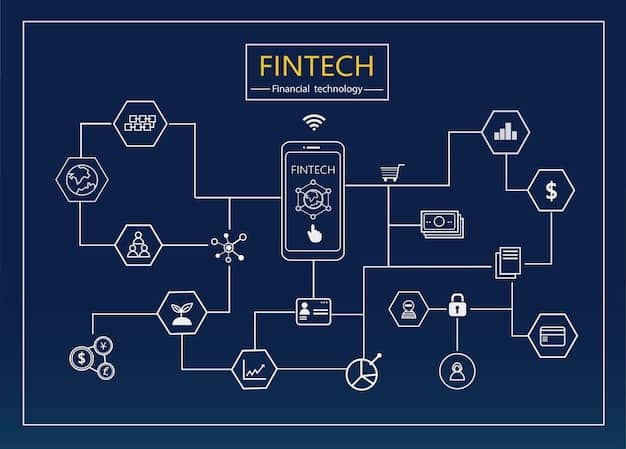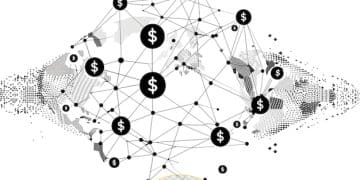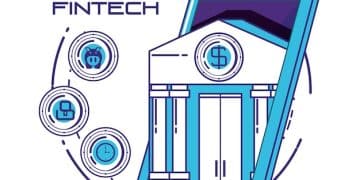Open Banking APIs: Redefining US Personal Finance by 2025

By 2025, Open Banking APIs are poised to fundamentally transform personal finance management in the US, enabling unprecedented data sharing, hyper-personalized services, and a more integrated financial ecosystem for consumers and institutions alike.
The financial landscape is in constant flux, driven by technological innovation and evolving consumer expectations. A pivotal force shaping its future is the emergence of Open Banking APIs, set to redefine personal finance management in the US by 2025. This transition promises to empower consumers with greater control over their financial data and foster a new era of personalized, efficient, and interconnected financial services.
The Genesis of Open Banking in the US
Open Banking, while gaining traction globally, is still in its nascent stages in the United States compared to regions like Europe and the UK. Historically, financial institutions in the US have operated with proprietary data systems, making it challenging for consumers to port their financial information between different services. This siloed approach often led to fragmented financial experiences and limited innovation from third-party developers.
However, the demand for greater financial autonomy and seamless digital experiences has spurred a gradual shift. Driven by consumer advocacy, competitive pressures, and implicit regulatory guidance, the US financial sector is slowly but surely embracing the principles of open banking. This involves the secure sharing of financial data through Application Programming Interfaces (APIs), enabling a richer ecosystem of financial products and services. The critical distinction in the US context is a less prescriptive regulatory mandate, favoring a market-driven evolution powered by consumer consent.
Navigating the Regulatory Landscape
Unlike explicit mandates seen in the EU with PSD2, the US approach to open banking is more nuanced. It’s largely influenced by the Consumer Financial Protection Bureau’s (CFPB) work under Section 1033 of the Dodd-Frank Act. This section grants consumers the right to access their financial data, forming the bedrock for open banking adoption. This regulatory framework, while not as prescriptive as its European counterparts, still encourages data portability and secure access via APIs. It’s about empowering consumers to share their data safely with third-party applications they trust, ultimately fostering greater competition and innovation among financial service providers.
- Consumer Financial Protection Bureau (CFPB): Pivotal in advocating for consumer data rights.
- Market-Driven Adoption: Financial institutions are responding to consumer demand and competitive pressures.
- Data Security Protocols: Emphasis on robust security frameworks to protect shared financial information.
The industry is actively working on technical standards through collaborative efforts, rather than just waiting for strict governmental directives. This collaborative approach, involving financial institutions, fintechs, and other stakeholders, is designed to ensure interoperability and security for open banking initiatives. The goal is to build a robust and trustworthy infrastructure that supports a new generation of financial tools.
Ultimately, the underlying principle is consumer control. Open banking in the US is evolving to enable individuals to grant explicit consent for their data to be shared, ensuring transparency and reducing concerns over privacy. This shift is not merely technological; it’s a fundamental change in how financial power is distributed, moving more control into the hands of the end-user.
Enhanced Personalization in Financial Management
The most profound impact of open banking APIs on personal finance management (PFM) will be the unprecedented level of personalization they enable. By aggregating data from various financial accounts—checking, savings, credit cards, investments, and even loans—PFM tools will gain a holistic view of an individual’s financial ecosystem. This rich data set allows AI-powered algorithms to deliver highly tailored advice and product recommendations, moving far beyond generic budgeting tips.
Imagine a financial app that not only tracks your spending but also understands your unique habits, predicts future cash flow based on upcoming bills and income, and actively suggests optimal credit card rewards for specific purchases or alerts you to better mortgage rates as they become available. This level of insight becomes truly actionable when all your financial data is accessible and integrated securely through APIs, creating a dynamic and responsive financial planning experience.

Tailored Product Recommendations and Seamless Onboarding
Open banking APIs will empower PFM platforms to act as intelligent financial advisors, offering products precisely matched to individual needs and risk profiles. For example, a platform could identify that a user consistently pays high-interest credit card debt and proactively suggest a lower-interest balance transfer option from a partner bank. This is not just about advertising; it’s about connecting users with solutions that genuinely improve their financial well-being, based on their actual financial behavior and goals.
- Hyper-personalized advice: AI-driven recommendations based on comprehensive financial data.
- Proactive problem-solving: Automated alerts and suggestions for optimizing debt, savings, and investments.
- Streamlined application processes: Pre-filled forms and instant approvals for financial products.
Furthermore, the onboarding process for new financial products will become significantly smoother. Instead of manually entering bank details or income statements, consumers can authorize the secure sharing of this information directly from their existing financial institutions. This reduces friction, accelerates approvals for loans, credit cards, or investment accounts, and dramatically improves the user experience. The era of tedious paperwork and lengthy waiting periods for financial services will gradually become a relic of the past, replaced by instant, data-driven interactions.
This personalization extends beyond mere product recommendations to encompass ongoing financial education and guidance. PFM tools, leveraging open banking data, can provide customized insights into spending patterns, identify areas for improvement, and offer actionable steps toward achieving financial goals, whether it’s saving for a down payment or planning for retirement. The user truly becomes the architect of their financial future, supported by intelligent, data-driven tools.
Real-Time Financial Visibility and Control
One of the most immediate and tangible benefits of open banking APIs for personal finance will be the ability to gain real-time visibility into one’s entire financial life. Currently, many individuals juggle multiple banking apps, credit card statements, and investment portfolios, leading to a fragmented and often delayed understanding of their financial position. Open banking APIs will change this by enabling a single, unified dashboard that updates account balances, transactions, and investment performance in real-time.
This immediate access to comprehensive financial data means consumers can make more informed decisions on the fly. Whether it’s checking if there are sufficient funds before a large purchase, monitoring unusual activity for fraud detection, or seeing the immediate impact of an investment decision, real-time data flow is a game-changer. This granular, up-to-the-minute information empowers individuals to maintain tighter control over their money and react swiftly to changing circumstances.
Budgeting and Expense Tracking Reinvented
Traditional budgeting often feels like a chore, requiring manual categorization and reconciliation. Open banking APIs automate much of this process. PFM apps can automatically pull transaction data, categorize spending, and even identify subscription services the user might have forgotten. This not only saves time but also provides a far more accurate picture of where money is going, without the need for manual input or reconciliation from the user.
- Automated categorization: AI-driven classification of expenses for effortless budgeting.
- Alerts and notifications: Real-time updates on spending thresholds, low balances, or suspicious activity.
- Predictive cash flow: AI models project future balances based on recurring income and expenses.
Furthermore, these apps can provide proactive alerts. Imagine being notified if you’re about to exceed your monthly dining budget, or if a recurring subscription price has increased. This level of active financial management, fueled by real-time data, transforms budgeting from a retrospective exercise into a dynamic, forward-looking process. Consumers gain not just visibility, but also the tools to course-correct in their spending and saving habits as they happen, leading to better financial outcomes.
The ability to integrate seamlessly with various financial products means PFM apps can offer more than just budgeting. They can suggest appropriate savings transfers when surplus funds are detected, or alert users to potential overdrafts before they occur, offering solutions like micro-loans or short-term credit from integrated partners. This proactive, intelligent management of finances will become the new standard, moving beyond mere reporting to active financial optimization.
The Rise of Super-Apps and Integrated Ecosystems
Open banking APIs are laying the groundwork for the emergence of “super-apps” in personal finance. These platforms will consolidate a vast array of financial services—from banking and payments to investments, insurance, and even loyalty programs—into a single, interconnected user experience. Instead of navigating separate apps for each financial need, consumers will have a unified portal that provides a holistic view and management capabilities for all their monetary interactions.
This integration goes beyond simple data aggregation. It implies a seamless flow of functionality, where users can apply for a loan, modify investment portfolios, compare insurance quotes, and pay bills, all from within one trusted application. The convenience and efficiency offered by such super-apps will be a major draw for consumers, simplifying their financial lives and reducing the cognitive load associated with managing multiple financial relationships.
Collaborative Innovation and Competitive Landscapes
The open banking framework fosters an environment of collaborative innovation. Fintech startups and established banks can leverage APIs to build new, specialized services that address specific consumer needs. For instance, a small fintech could develop an app focused solely on helping users optimize student loan repayments by connecting to various bank and loan provider APIs, offering personalized strategies that traditional banks might not prioritize.
- Unified financial platform: Consolidating diverse financial services into a single app.
- Accelerated innovation: Easier for fintechs to build specialized, value-added services.
- Increased competition: Drive improvements in service quality and pricing across the financial sector.
This open ecosystem will intensify competition across the financial sector. Banks that embrace open APIs will be able to partner with innovative fintechs, offering enhanced services to their customers, while those that resist might find themselves losing market share to more agile competitors. This competitive pressure will ultimately benefit consumers through better products, more transparent pricing, and improved customer experiences. The focus will shift from just core banking services to providing a comprehensive, integrated financial well-being platform.
The interoperability brought by open banking APIs also encourages the creation of niche financial products designed for specific demographics or needs. Think of apps designed for freelance workers, providing integrated tax preparation and income smoothing tools by connecting to various income streams and expense accounts. This granularity of service, previously difficult to achieve, becomes viable with streamlined data access, catering to underserved segments of the market and promoting financial inclusion.
Enhanced Security and Fraud Prevention
A common misconception about open banking is that it compromises security. In reality, well-implemented Open Banking APIs are designed with robust security protocols that can actually enhance financial protection compared to traditional methods. Instead of sharing login credentials with third-party apps—a risky practice known as “screen scraping”—open banking relies on secure, tokenized authorization. This means consumers grant explicit permission for specific data points to be shared, without ever exposing their full banking login details to the third party.
This token-based access revokes access anytime the user chooses, giving them fine-grained control over who sees which data and for how long. Furthermore, financial institutions and fintechs must adhere to stringent data protection standards and encryption protocols, often exceeding the security measures of legacy systems. The entire framework emphasizes secure data transmission and segregation, minimizing the risk of data breaches and unauthorized access.
Building Trust Through Transparency and Control
Trust is paramount in financial services, and open banking aims to build it through transparency. Consumers are given clear visibility into what data is being shared, with whom, and for what purpose. This explicit consent model stands in stark contrast to opaque data-sharing practices that sometimes occur without the user’s full awareness. By putting the user in the driver’s seat of their data, open banking fosters a stronger sense of security and confidence.
- Tokenized authorization: Replaces credential sharing with secure data access tokens.
- Granular control: Users dictate precisely what data is shared and with which entities.
- Enhanced monitoring: Consolidated view across accounts aids in early fraud detection.
Moreover, the consolidated view that PFM apps enabled by open banking offer can actually improve fraud detection. By monitoring transactions across all accounts in real-time, these apps can identify unusual patterns or suspicious activities more swiftly than managing each account separately. An alert for an unexpected transaction across different banks can be triggered instantly, allowing for quicker action to mitigate potential fraud. This proactive monitoring adds a crucial layer of defense against financial crime.
The continuous innovation in cybersecurity will also play a critical role. As open banking matures, so too will the security infrastructure surrounding it, integrating advanced authentication methods, AI-powered threat detection, and continuous vulnerability assessments. This collaborative approach to security, involving the entire ecosystem, ensures that as data sharing becomes more prevalent, so does the resilience against potential threats, ultimately safeguarding consumer finances more effectively.
Challenges and the Path Forward for Widespread Adoption
While the promise of open banking APIs is immense, several challenges must be overcome for widespread adoption in the US by 2025. One primary hurdle is the fragmented regulatory environment, as mentioned earlier. Without a unified, top-down mandate similar to Europe’s PSD2, progress relies heavily on industry initiatives and consumer demand, which can lead to slower, less consistent implementation across various financial institutions. Different banks might adopt different standards or prioritize API development at varying paces, creating uneven experiences.
Another significant challenge lies in data standardization. For open banking to be truly seamless, there needs to be common agreement on how financial data is structured and exchanged across diverse platforms. Without this, PFM apps may struggle to interpret and aggregate data effectively, limiting their functionality. Overcoming this will require ongoing collaboration between banks, fintechs, and industry bodies to establish universal protocols for data formatting and transmission.
Consumer Trust and Education
Perhaps the most critical challenge is building and maintaining consumer trust. Despite the security benefits, many consumers remain wary of sharing their financial data, often due to a lack of understanding about how open banking works and the safeguards in place. Extensive educational campaigns will be necessary to clearly explain the benefits, articulate the security measures, and assure consumers they retain full control over their data.
- Regulatory fragmentation: Inconsistent adoption rates due to varied approaches.
- Data standardization: Need for unified protocols for data exchange across institutions.
- Consumer education: Crucial for building trust and promoting understanding of benefits and security.
Overcoming these trust barriers will involve transparent communication, explicit consent mechanisms, and a track record of secure, beneficial user experiences. Platforms leveraging open banking must prioritize user-friendly interfaces that clearly delineate data permissions and allow for easy revocation of access when desired. Without trust, even the most innovative open banking solutions will struggle to gain traction among the broader US population.
Finally, the existing infrastructure within many older financial institutions presents a modernization challenge. Migrating from legacy systems to API-ready architectures requires significant investment in technology and human capital. This transition can be costly and time-consuming, potentially delaying broader rollouts. However, the long-term benefits in terms of innovation, customer satisfaction, and competitive advantage are likely to drive this necessary evolution, paving the way for a truly transformed personal finance management landscape.
| Key Aspect | Brief Description |
|---|---|
| 🚀 Enhanced Personalization | Tailored financial advice & product recommendations through aggregated data. |
| ⏰ Real-Time Visibility | Unified dashboards for up-to-the-minute financial data across all accounts. |
| 🛡️ Improved Security | Tokenized authorization and explicit consent replace insecure credential sharing. |
| 🌐 Integrated Ecosystems | Rise of “super-apps” consolidating diverse financial services for seamless management. |
Frequently Asked Questions About Open Banking APIs
Open Banking APIs (Application Programming Interfaces) are standardized sets of rules and protocols that allow banks to securely share financial data with third-party applications and services, with explicit customer consent. This enables data portability and fosters a more interconnected financial ecosystem, leading to innovative personal finance tools and services that can access and aggregate information from various accounts.
Unlike regions like Europe and the UK, which have prescriptive regulatory mandates (e.g., PSD2), the US approach is more market-driven. It’s largely influenced by the CFPB’s emphasis on consumer data rights, encouraging adoption through industry collaboration rather than strict rulemaking. This means a less centralized, but still evolving, framework guided by consumer consent and the need for secure data sharing protocols for a consistent user experience.
The primary benefits include hyper-personalization, real-time financial visibility, and enhanced control. Consumers will gain access to tools that aggregate all their financial data into one dashboard, offering tailored advice, automated budgeting, and seamless onboarding for new products. This empowers users to make more informed decisions, manage their money more efficiently, and achieve their financial goals with greater ease and precision.
Yes, well-implemented Open Banking APIs are highly secure. They replace the risky practice of sharing login credentials with tokenized authorization, meaning you grant specific, revocable permissions for data sharing without exposing your full bank access. This framework adheres to stringent encryption and data protection standards, often providing a more secure method of data access compared to older methods and increasing transparency by giving you full control over your financial information.
Key challenges include regulatory fragmentation, a lack of universal data standardization across US institutions, and the need to build robust consumer trust. Educating the public about the benefits and security protocols is crucial. Additionally, older financial institutions may face challenges in modernizing legacy systems to support API-driven data sharing. Overcoming these hurdles will require ongoing industry collaboration and clear communication to consumers.
Conclusion
By 2025, Open Banking APIs are set to be a transformative force in how Americans manage their personal finances. From hyper-personalized budgeting to real-time financial visibility and the rise of integrated “super-apps,” the future promises a more intuitive, efficient, and user-centric financial experience. While challenges related to regulation, standardization, and trust remain, the trajectory is clear: consumers will gain unprecedented control and insight into their financial lives. This evolution signals a fundamental shift towards an interconnected financial ecosystem, empowering individuals to navigate their monetary journeys with greater confidence and intelligence, ultimately leading to improved financial well-being across the US.





